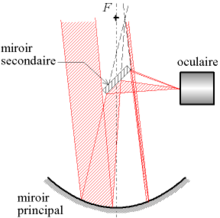Catoptrics

Catoptrics (from Greek: κατοπτρικός katoptrikós, "specular",[1] from Greek: κάτοπτρον katoptron "mirror"[2]) deals with the phenomena of reflected light and image-forming optical systems using mirrors. A catoptric system is also called a catopter (catoptre).
Ancient texts
Catoptrics is the title of two texts from ancient Greece:
- The Pseudo-Euclidean Catoptrics. This book is attributed to Euclid,[3] although the contents are a mixture of work dating from Euclid's time together with work which dates to the Roman period.[4] It has been argued that the book may have been compiled by the 4th century mathematician Theon of Alexandria.[4] The book covers the mathematical theory of mirrors, particularly the images formed by plane and spherical concave mirrors.
- Hero's Catoptrics. Written by Hero of Alexandria, this work concerns the practical application of mirrors for visual effects. In the Middle Ages, this work was falsely ascribed to Ptolemy. It only survives in a Latin translation.[5]
The
Kamal al-Din al-Farisi (d. ca. 1320) in the latter's Kitab Tanqih al-Manazir (The Revision of [Ibn al-Haytham's] Optics).[9]
Catoptric telescopes
The first practical catoptric
Newtonian reflector") was built by Isaac Newton as a solution to the problem of chromatic aberration exhibited in telescopes using lenses as objectives (dioptric
telescopes).
See also
- Dioptrics
- Catadioptrics
- Optical telescope
- List of telescope types
- Image-forming optical system
- Fresnel lens
- Lighthouse lens
References
- ^ A Concise Dictionary of the English and Modern Greek Languages by Antonius Nicholas Jannaris, 1895 J. Murray
- ^ "Henry George Liddell, Robert Scott, An Intermediate Greek-English Lexicon, κάτοπτρον". Retrieved 2015-03-13.
- ^ Reading Euclid by J. B. Calvert, 2000 Duke U. accessed 23 October 2007
- ^ a b O'Connor, John J.; Robertson, Edmund F., "Catoptrics", MacTutor History of Mathematics Archive, University of St Andrews, accessed 31 January 2013
- ISBN 0871698935
- ^ Grant 1974 p.392 notes the Book of Optics has also been denoted as Opticae Thesaurus Alhazen Arabis, as De Aspectibus, and also as Perspectiva
- ^ (Lindberg 1996, p. 11), passim
- ^ (Dr. Al Deek 2004)
- ^ (El-Bizri 2005a)
(El-Bizri 2005b)
Bibliography
- S2CID 123057532
- OCLC 218847614
- Dr. Al Deek, Mahmoud (2004), "Ibn Al-Haitham: Master of Optics, Mathematics, Physics and Medicine", Al Shindagah (November–December 2004), archived from the original on 2008-06-17, retrieved 2013-09-04
- Grant, Edward (1974), A Source Book in Medieval Science, Harvard University Press, ISBN 978-0-674-82360-0
- Lindberg, David C. (1996), Roger Bacon and the Origins of Perspectiva in the Middle Ages, Clarendon Press
